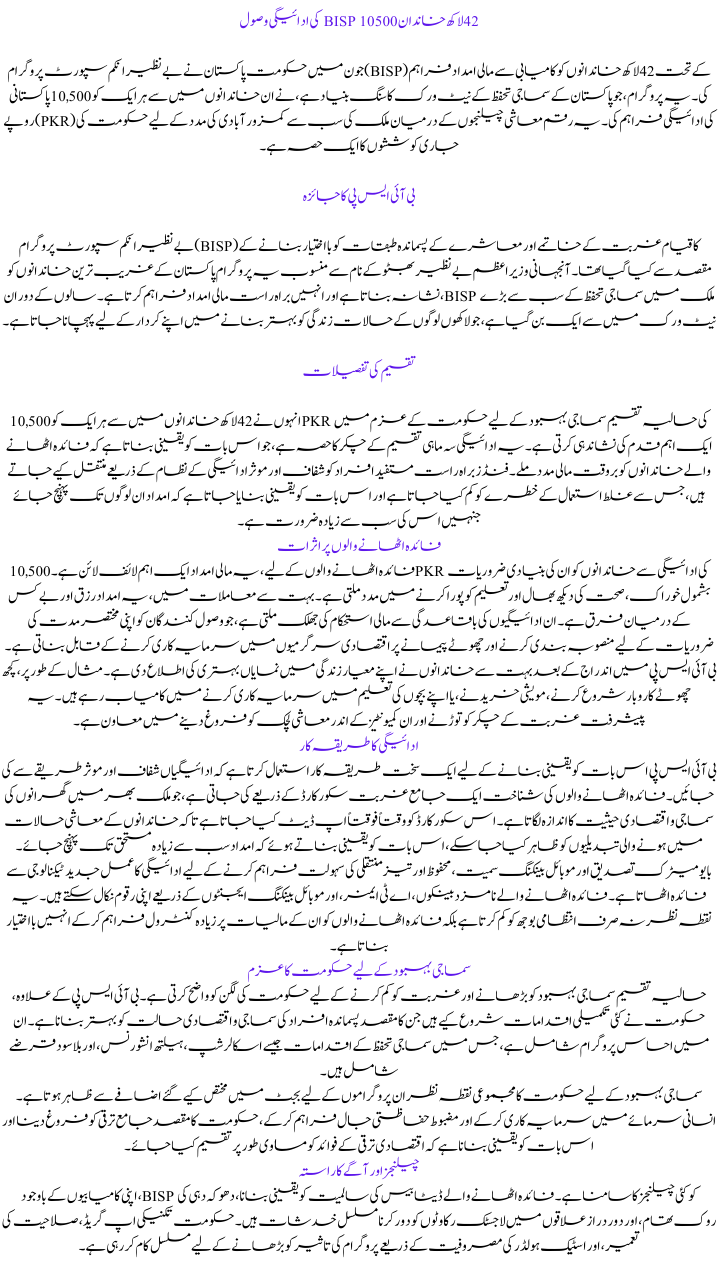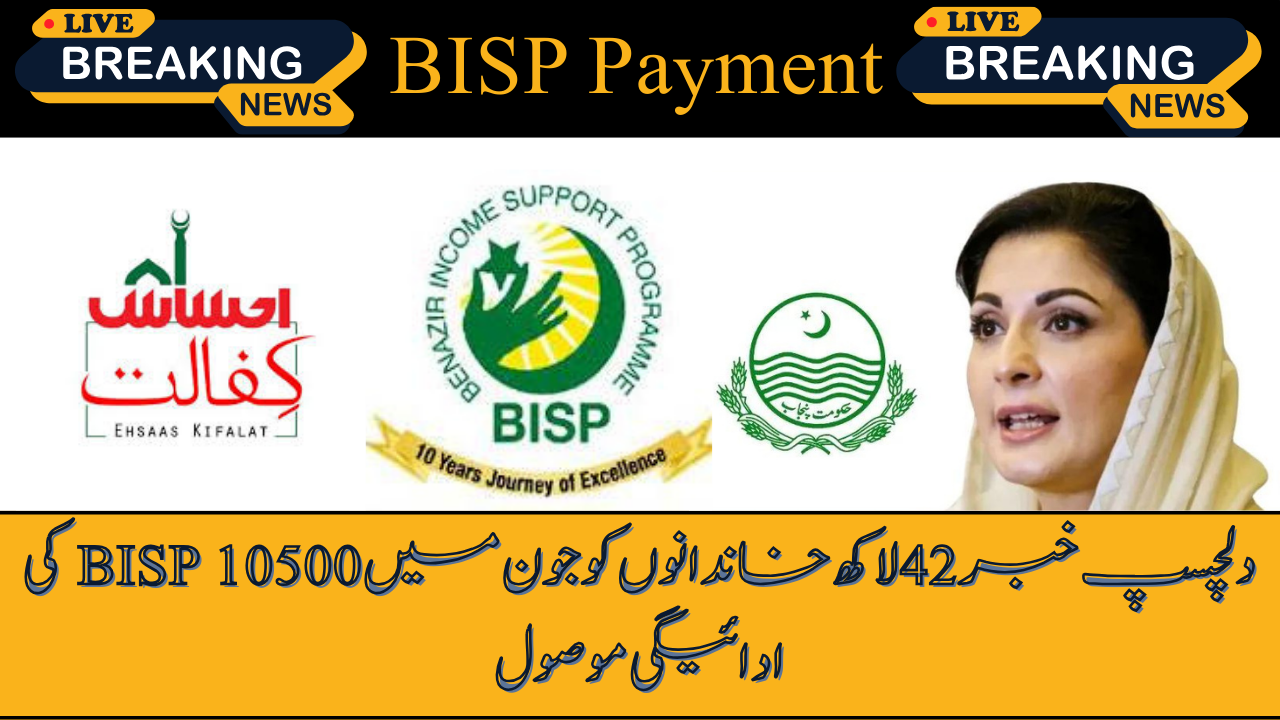42 Lakh Families Receive BISP 10500 Payment
In June, the Government of Pakistan successfully disbursed financial assistance to 42 lakh families under the Benazir Income Support Programme (BISP). This program, which is a cornerstone of Pakistan’s social safety net, provided each of these families with a payment of 10,500 Pakistani Rupees (PKR). The disbursement is a part of the government’s ongoing efforts to support the country’s most vulnerable populations amidst economic challenges.
Overview of BISP
The Benazir Income Support Programme (BISP) was established with the aim of alleviating poverty and empowering the underprivileged segments of society. Named after the late Prime Minister Benazir Bhutto, the program targets the poorest families in Pakistan, providing them with direct financial assistance. Over the years, BISP has grown to become one of the largest social safety nets in the country, recognized for its role in improving the living conditions of millions of people.
Disbursement Details
The recent disbursement of 10,500 PKR to each of the 42 lakh families marks a significant step in the government’s commitment to social welfare. This payment is part of a quarterly disbursement cycle, which ensures that beneficiary families receive timely financial support. The funds are transferred directly to beneficiaries through a transparent and efficient payment system, minimizing the risk of misappropriation and ensuring that the assistance reaches those who need it most.
Impact on Beneficiaries
For the beneficiaries, this financial support is a crucial lifeline. The 10,500 PKR payment helps families meet their basic needs, including food, healthcare, and education. In many cases, this assistance is the difference between subsistence and destitution. The regularity of these payments provides a semblance of financial stability, enabling recipients to plan for their short-term needs and invest in small-scale economic activities.
Many families have reported significant improvements in their quality of life since enrolling in BISP. For instance, some have been able to start small businesses, purchase livestock, or invest in their children’s education. These developments contribute to breaking the cycle of poverty and fostering economic resilience within these communities.
Mechanism of Payment
BISP employs a rigorous mechanism to ensure that payments are made transparently and efficiently. Beneficiaries are identified through a comprehensive poverty scorecard, which assesses the socio-economic status of households across the country. This scorecard is periodically updated to reflect changes in the economic conditions of families, ensuring that the assistance reaches the most deserving.
The disbursement process leverages modern technology, including biometric verification and mobile banking, to facilitate secure and swift transfers. Beneficiaries can withdraw their funds through designated banks, ATMs, and mobile banking agents. This approach not only reduces the administrative burden but also empowers beneficiaries by providing them with greater control over their finances.
Government’s Commitment to Social Welfare
The recent disbursement underscores the government’s dedication to enhancing social welfare and reducing poverty. In addition to BISP, the government has launched several complementary initiatives aimed at improving the socio-economic conditions of the underprivileged. These include the Ehsaas Programme, which encompasses a broad spectrum of social safety measures such as scholarships, health insurance, and interest-free loans.
The government’s holistic approach to social welfare is evident in its increased budgetary allocations for these programs. By investing in human capital and providing robust safety nets, the government aims to foster inclusive growth and ensure that the benefits of economic development are equitably distributed.
Challenges and the Way Forward
Despite its successes, BISP faces several challenges. Ensuring the integrity of the beneficiary database, preventing fraud, and addressing logistical hurdles in remote areas remain ongoing concerns. The government is continuously working to enhance the program’s effectiveness through technological upgrades, capacity building, and stakeholder engagement.

One of the key areas of focus is improving outreach and awareness. Many eligible families are still unaware of the program or find it difficult to navigate the enrollment process. The government is undertaking extensive awareness campaigns and simplifying procedures to ensure broader coverage.
Another challenge is the sustainability of funding. As the number of beneficiaries grows, so does the financial burden on the state. The government is exploring various avenues, including international partnerships and donor assistance, to ensure the program’s long-term viability.
Conclusion
The disbursement of 10,500 PKR to 42 lakh families in June is a testament to the transformative impact of the Benazir Income Support Programme. By providing critical financial assistance to the poorest segments of society, BISP plays a pivotal role in alleviating poverty and promoting social equity. The government’s unwavering commitment to social welfare, coupled with continuous improvements in program implementation, promises a better future for millions of Pakistanis.
As BISP evolves, it remains a beacon of hope for those struggling at the margins of society. Its success stories highlight the potential of well-designed social safety nets to drive positive change and uplift communities. With sustained efforts and strategic enhancements, BISP is poised to make even greater strides in the fight against poverty, contributing to a more inclusive and prosperous Pakistan.
